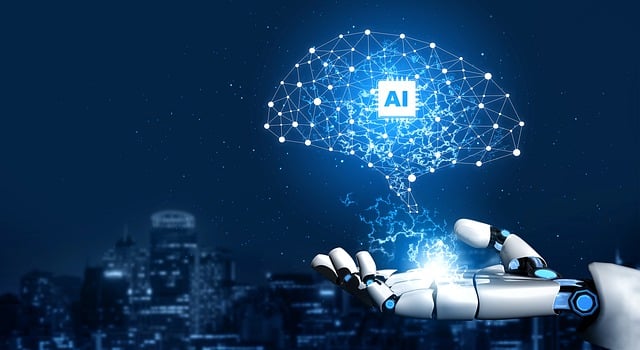AI in Education: Enhancing Learning Experiences and Administrative Efficiency

Artificial Intelligence (AI) is revolutionizing industries worldwide, and education is no exception. From personalized learning pathways for students to streamlining administrative tasks, AI is transforming the educational landscape. In this article, we explore how AI is enhancing learning experiences and boosting administrative efficiency, ultimately reshaping how education is delivered and managed.
Table of Contents
The Role of AI in Modern Education
AI has become a critical component in the education sector by addressing both learning challenges and operational inefficiencies. With its ability to analyze vast amounts of data, adapt to individual learning styles, and automate routine tasks, AI provides educators and administrators with powerful tools to enhance outcomes.
How AI Enhances Learning Experiences
1. Personalized Learning Paths
AI-powered systems analyze student performance, learning habits, and preferences to create tailored educational experiences.
- Example: Platforms like Khan Academy use AI to recommend lessons based on individual progress.
- Benefit: Students learn at their own pace, leading to improved comprehension and retention.
2. Intelligent Tutoring Systems (ITS)
AI-driven tutoring systems provide students with instant feedback and assistance outside the classroom.
- Example: Tools like Duolingo offer language learning powered by AI algorithms that adapt to user proficiency.
- Benefit: These systems make learning accessible anytime, fostering continuous education.
3. Gamification and Engagement
AI integrates gamification elements into educational content to increase student engagement.
- Example: Educational games on platforms like Prodigy adapt questions and challenges based on student skills.
- Benefit: Gamification encourages active participation and a love for learning.
4. Language Translation and Accessibility
AI-powered translation tools break down language barriers, making education more inclusive.
- Example: Google Translate and AI captioning tools help non-native speakers and students with hearing impairments.
- Benefit: Enhances access to quality education for diverse populations.
5. Virtual Reality (VR) and Augmented Reality (AR)
When combined with AI, VR and AR create immersive educational experiences.
- Example: Apps like Google Expeditions allow students to explore virtual historical sites or dissect virtual organisms.
- Benefit: Enhances understanding of complex concepts through interactive visuals.
AI Streamlining Administrative Efficiency
1. Automating Routine Tasks
AI systems can automate repetitive tasks like attendance tracking, grading, and scheduling.
- Example: Software like GradeScope grades essays and exams with minimal human intervention.
- Benefit: Saves teachers time, allowing them to focus on teaching and mentoring.
2. Predictive Analytics for Resource Allocation
AI analyzes data to predict student enrollment trends and optimize resource distribution.
- Example: Universities use AI to forecast demand for courses, ensuring adequate staffing and materials.
- Benefit: Improves resource management and reduces waste.
3. Chatbots for Student Support
AI chatbots provide instant responses to common student inquiries, from course details to application processes.
- Example: Purdue University’s Purdue Owl chatbot assists students with writing-related queries.
- Benefit: Reduces the workload on administrative staff while enhancing student satisfaction.
4. Fraud Detection in Applications
AI tools help detect discrepancies in application documents, ensuring fair admissions processes.
- Example: Some universities employ AI to verify academic credentials and identify fraudulent applications.
- Benefit: Maintains the integrity of the admissions process.
5. Campus Security and Monitoring
AI-driven surveillance systems improve campus safety by identifying suspicious activities in real-time.
- Example: AI-enabled cameras and facial recognition tools are used to monitor unauthorized access.
- Benefit: Ensures a secure learning environment.
Case Studies: AI in Action
Case Study 1: Squirrel AI Learning (China)
Squirrel AI uses adaptive learning algorithms to customize math and science lessons for students.
- Result: Students reported a 30% improvement in test scores.
Case Study 2: Georgia State University
Georgia State implemented an AI chatbot, “Pounce,” to guide incoming students through the enrollment process.
- Result: Increased enrollment rates by 3.9%.
Case Study 3: Carnegie Mellon University
Carnegie Mellon developed AI-based learning systems to teach programming and mathematics.
- Result: Enhanced problem-solving skills and deeper conceptual understanding.
Введите текст заголовка
Despite its benefits, AI implementation in education faces hurdles:
1. Data Privacy Concerns
AI systems rely on vast amounts of student data, raising concerns about data security and privacy.
- Solution: Institutions must adopt robust data encryption and compliance with regulations like GDPR.
2. Digital Divide
Access to AI-driven tools requires stable internet and modern devices, creating a gap between privileged and underprivileged students.
- Solution: Governments and organizations must invest in infrastructure and provide affordable solutions.
3. Resistance to Change
Teachers and administrators may resist AI adoption due to lack of technical knowledge or fear of job displacement.
- Solution: Training programs and demonstrations can highlight AI’s role as an enabler rather than a replacer.
4. Ethical AI Use
Biased algorithms can perpetuate discrimination in grading or admissions.
- Solution: Develop diverse and transparent datasets for unbiased AI decision-making.
The Future of AI in Education
The potential of AI in education is boundless. Innovations like generative AI, blockchain-powered credentialing, and emotion-recognition AI promise to make learning more engaging and efficient.
Emerging Trends
- Micro-Learning: Bite-sized, AI-curated lessons to suit busy lifestyles.
- AI for Lifelong Learning: Tools for continuous skill development in evolving industries.
- Decentralized Education: Blockchain and AI enabling secure, universal credential sharing.
AI is not just a tool for enhancing education—it’s a transformative force. By personalizing learning experiences, automating administrative tasks, and making education accessible, AI is shaping the future of learning. While challenges exist, the benefits of AI in education far outweigh the drawbacks.
